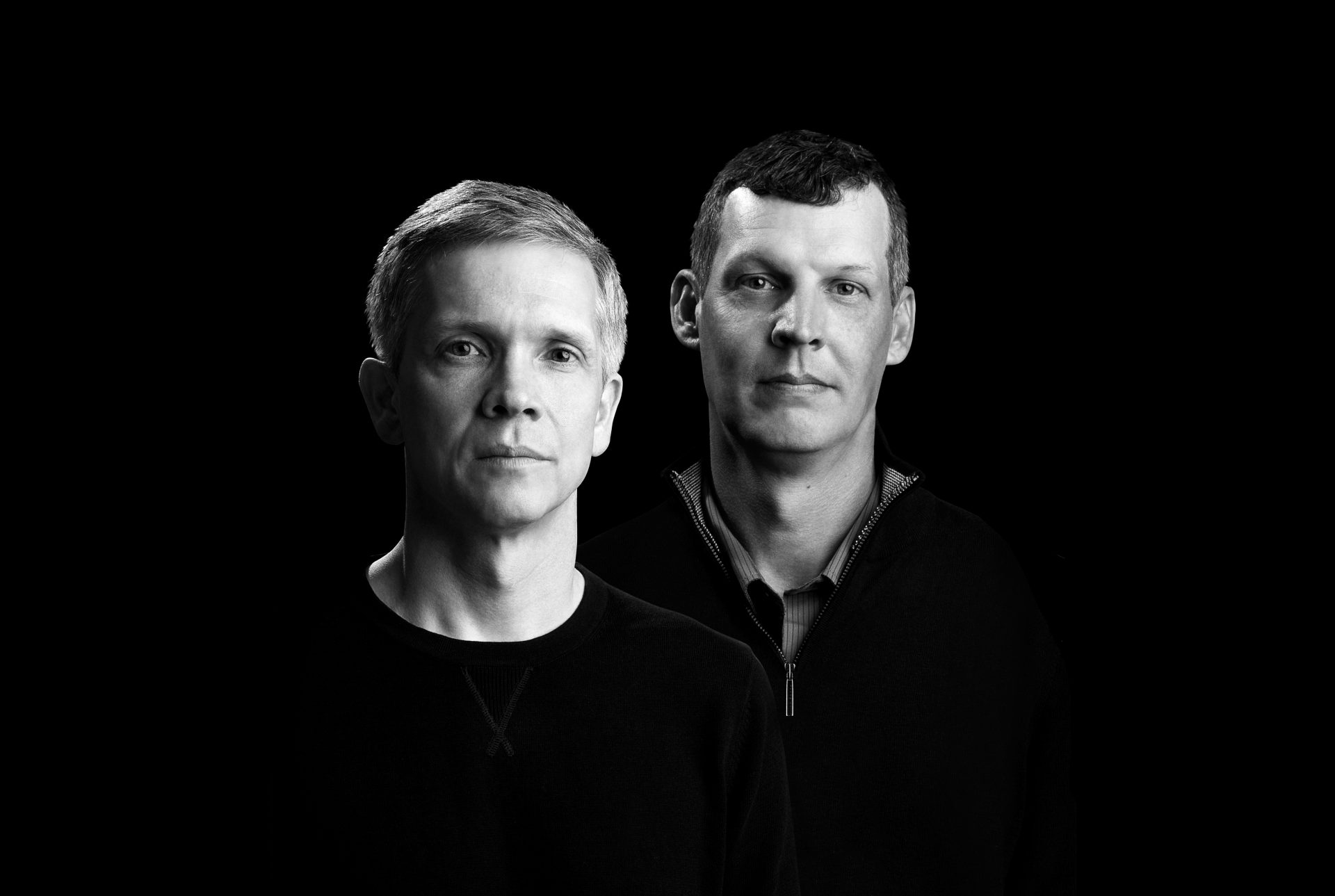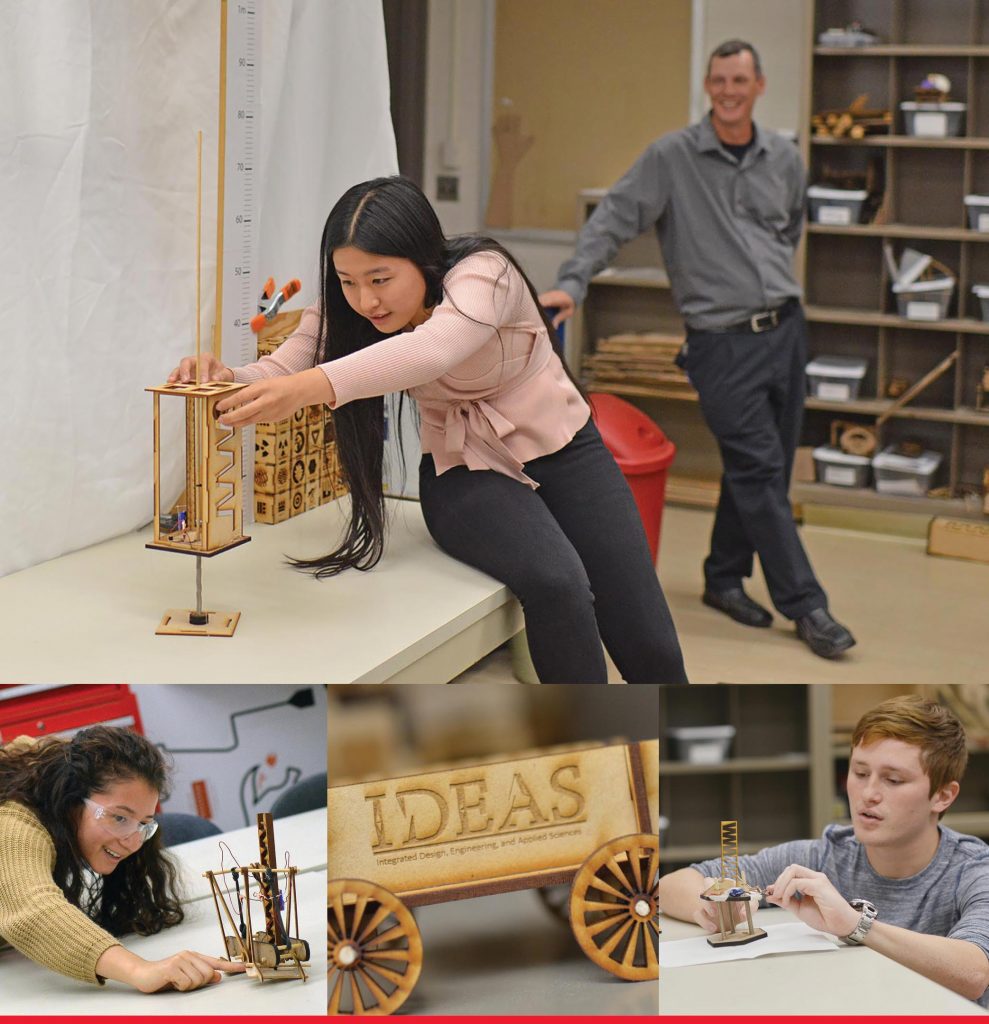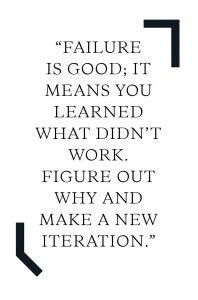IDEAS: Putting the Art in Smart Design

Biographer Walter Isaacson—who wrote about Albert Einstein, Leonardo da Vinci, and Steve Jobs—has said, “Those who thrive at the intersections of arts and sciences are the ones who will become a part of history.” Wesleyan’s cohort of students in the IDEAS minor may be preparing for just such a destiny. Photo by: Robert Adam Mayer
In the basement of Exley Science Center, Assistant Professor of the Practice Daniel Moller is teaching a section of Introduction to Design and Engineering, where he writes on the board, “Fail Early and Often.”
The 16 students in the class are engrossed in building their first independently designed creation: something that will hop (“actually leap up off the table,” says Moller), but only after a delay of at least eight seconds, and fewer than 60.
“The trigger/timing device often proves to be the most challenging part,” Moller notes.
The assignment, just given out last week along with a kit of items that may be used in the hopper construction—1/8-inch medium-density fiberboard (MDF), three springs, three foot-long dowels, lengths of rubber tubing and fishing line, two balloons and a few sundry nuts, bolts, and washers—will be due just before fall break in a class meeting designated the “Hopper Celebration.”
 In September, though, no one looks particularly festive. Students are mostly at their lab tables, eyes focused on notebooks or peering at laptops. Brows are furrowed in concentration as some are wrapping balloons around dowels and pieces of wood, and a few students are consulting with classmates. Others work at the adhesion station in the back of the room, glue gun in hand, and one or two stand at the computer connected with the laser cutter in the front of the class. The acrid-sweet smell of the laser-burned MDF lingers, even with the noisy exhaust fan flipped on.
In September, though, no one looks particularly festive. Students are mostly at their lab tables, eyes focused on notebooks or peering at laptops. Brows are furrowed in concentration as some are wrapping balloons around dowels and pieces of wood, and a few students are consulting with classmates. Others work at the adhesion station in the back of the room, glue gun in hand, and one or two stand at the computer connected with the laser cutter in the front of the class. The acrid-sweet smell of the laser-burned MDF lingers, even with the noisy exhaust fan flipped on.
SolidWorks, an engineering design program, helps them use the laser cutter for rapid prototyping, a practice Moller tells them is essential for success in the engineering design industry these days. For their hopper, students can design parts with SolidWorks and laser cut them from MDF.
By ”fail early,” Moller actually means “don’t procrastinate.’ He wants students to find out quickly if the thing they are imagining is, in reality, workable or not. He also elaborates on “fail often” from the front of the class. It’s encouragement, of a sort. “Failure is good; it means you learned what didn’t work. Figure out why and make a new iteration. Ideate, prototype, test.”
Some students look up. They’ve heard this a number of times already, although the semester is still young. Moller melts back into the class, continuing his rounds checking in with each student, listening intently, asking and answering questions, noting possible design concerns, and suggesting work-arounds.
“You’d want all the springs to release simultaneously,” he tells one student, “in order to get the most energy and make it go straight up. Can you think of a way to do that?”
Tinkerers Vs. Theorists
Later, Professor of Physics Greg Voth, who developed the class and teaches the other section, fills in the history of this new minor at Wesleyan. The IDEAS minor—or Integrated Design, Engineering, and Applied Science—was conceived as 13 modules that range across the curriculum—from architecture to theater and digital design, from electronics through materials and physics.

“Fail early and fail often?” Voth says. “That’s our mantra. It’s our strategy for introducing students to building things.”
Within this minor, IDEAS 170: Introduction to Design and Engineering is a foundation course that Voth first offered in the spring of 2017, and it has been gaining buzz and enrollees ever since. Just a year-and-a-half later, Professor of Physics Francis Starr, who administers the program, notes that even with an added section this fall, “We still couldn’t accommodate all the students who wanted to take this class.’
So what is its appeal? And who are these students flocking to the classroom in the basement of Exley, where failures are a given, and sometimes celebrated?
”The concept of the IDEAS program is to get the students involved in making and designing things from the beginning,” Voth says. “Olin College of Engineering was having success with this new model, so we brought a version of it here.’
While traditional engineering education dictates the students receive several years of theory classes before being allowed to design, “we’ve found our students learn a tremendous amount of engineering fundamentals and practical experience by building from the beginning,” Voth says. “When they start designing with little experience or theory, they usually fail initially. But if they persist, the learning comes quickly.”
This inversion of standard protocol encourages a wider range of students to sign up. A quick survey of four students in IDEAS 170 offers up the full spectrum of Wesleyan’s curriculum: a first-year student considering a math major; a senior double-majoring in molecular biology and biochemistry and science in society; a junior double-majoring in American studies and film studies; a sophomore—as yet undeclared—but leaning toward art studio.
It’s a mix that not only strengthens the course, but invigorates the design process. Their mix of approaches will later allow the students to share strengths when they form groups for their final design project. In the beginning of the semester, however (until they learn to collaborate their way through challenging assignments), it makes for a quiet class. Students are apt to keep to themselves as they navigate new material and classmates with whom they had not previously crossed paths on campus.
Students arrive in IDEAS 170 with an aversion to failure. “They’ve been successful all their lives,” notes Moller. “Of course they don’t like it.” But they are quickly plunged into an unfamiliar culture. Rather than a culturally compelling “overnight success” storyline, they are now faced with one that rewards a careful, if clumsy, process in which they are able to trace their effective design back through all their failed iterations, discussing what they learned at each juncture.
“We want them to learn who they are as a designer,” Moller and Voth concur.
The professors offer two models for their students to consider. The first is the tinkerer, who has little background but immediately begins construction; the second is the theorist, who first learns to predict the behavior of a design before initiating construction. They suggest that a middle path may be worth pursuing, where a readiness to begin prototyping and an open, analytical mindset moves them ever closer to a completed, effective design.
”If you’re somewhere in between a tinkerer and theorist, you are always marching toward the physical realization of an optimal solution,” says Moller.
A Bumper Hopper Crop
 As another week or two goes by, the hoppers begin taking shape on desktops. They are as unique as their inventors.
As another week or two goes by, the hoppers begin taking shape on desktops. They are as unique as their inventors.
Rebekah, a prospective computer science major, has a clear design goal: a hopper that is also a piece of art. David, also planning for that major, is aiming for a three-foot hop. Sydney wants to rig hers up as a Rube Goldberg sort of device, requiring several pieces working in succession to trigger the release of energy that makes the hop. Asher wants his to do a backflip. Moller, who previously taught at an engineering college, observes a difference in these liberal arts students compared to those in his earlier classroom.
”Their mindsets come from all directions, so we get some really interesting, wacky, cool ideas—a lot more with aesthetic concerns,” he says. “I’d expect that engineering students would tend to produce mostly pogo sticks made with the rubber tubing—the most efficient design with the most energy-dense item in the kit.”
With the students experiencing some combination of frustration and anxiety, it’s time for the first of two design reviews. The professors have already met individually with each student and encouraged them to spend time in the lab, which is staffed evenings and weekends with student assistants who have taken IDEAS 170 before and are skilled at brainstorming and troubleshooting the current hopper crop.
In the design review, set up as an hour-long problem-solving critique, the professors meet with four students who describe their personal design goals, demonstrate their hopper, discuss problems they’ve encountered (along with solutions), and seek guidance and ideas from their group. A key message from both professors: “Learn from each other. If you see someone else has a solution that might work on your device, think about how you can adapt it and use it.”
It’s also in design review that some students confront what Voth calls one of the big lessons: What you can conceive of and what the universe will actually let you make work are not the same.
In review, Daniela has an elegantly framed creation made in SolidWorks to look like a grasshopper. Her design goal was to use a biological model of a hopper. The trouble is, this one slides more than hops. Is it too heavy? Or does it need a more vertical shape for lift-off? If she cuts holes in it, will it be strong enough to withstand the stress of the rubber tubing stretched around it to create the hop?
A number of students have three-legged devices, created from the logic of the kit, which offers three springs that seem to suggest one per leg. Voth writes the formula on the board that describes the energy that a spring will release and notes that putting greater weight above the springs when they release will set a greater amount of mass in motion. That’s the recipe for a larger hop.
After the first design review, when everyone has what Moller dubs as “hopper-ish,” the focus is on developing a timed trigger by the second review. A rocket igniter and a capacitor are options. Complete the circuit, and it will melt some fishing line that could be holding the hopper elements in place, releasing that potential energy in a hop. The drawback is this melt/release takes only a second. What will delay the circuit completion for seven additional seconds? Some consider a deflating balloon as part of the timer/switch mechanism. If it could be made to release its air slowly, maybe that would allow two conductive contacts to close the circuit only after the prescribed eight seconds?
The classes have adopted a collaborative workshop demeanor, with conversations flowing around their work. Some hoppers have become functional and punctuate class time with their sudden leap.
In one of Voth’s second reviews, Sara shares her design challenges. Her timer is a series of pendulums that ultimately release the fishing line that has kept the hopper’s legs folded underneath. She needs the pendulums to be slower, however, so that a full eight seconds elapse from when she sets it in motion to when the legs spring up into a hop.
“Anyone know how to get the most time from a pendulum?” asks Voth.
“Increase the length,” one student says.
“The drawback is that if you add length, you’ll add weight and need more force to make it hop. Any ideas on how to make it lighter?”
“You could cut out holes in the MDF, so the pieces aren’t solid,” suggests another.
“How about ways to make its construction more efficient for prototyping?” asks Voth. “Sara said it took her three hours to glue it.”
“You could use slots and tabs, so the pieces would lock into place.”
Discussions continue and at one point a student offers a hopeful suggestion to a seemingly untenable design, adding, “We’re all in this together.”
Launch Day
The day of the Hopper Celebrations, the basement classroom has a festive atmosphere, with party treats set up near the drill press in the back of the room. Conversations abound, giving an aura of preshow jitters, heightened in some cases, perhaps, by the giddiness of sleep deprivation.
“Public Safety called at 4 a.m. to tell me that one of you was here in the lab,” Voth says, nodding in the direction of one slightly wilted-looking student.
“I was here until 1:30,” someone adds.
“You stayed that late? I left at 11,” another says.
A few others admit to early-morning construction events.
“I got it to work several times last night and I put it away until this morning and now it won’t work,” one laments.
“Yes,” Voth observes. “Making a device that will work and making one that will work each time you want to use it are sometimes different things.”
The hoppers—all different sizes and shapes, from compact to gangly, elegant to rough—sit on lab tables like so many trophies. One at a time, students carry their creation to the front of the room, state their personal design goal, review their design process and failures they overcame to arrive at this form, and set it down to let it show off its single talent.
Here is the climax of the past few weeks, expressed not only in the wide spectrum of creativity, the convergence of art and science, but also in the simple collective joy released with each hop. It is the elemental emotion of surprise after bated breath. Each time a device performs its function, the class breaks into spontaneous applause.
Several times the wait is extended.
“Sixty seconds,” announces Moller, stopwatch in hand. Still no hop. Finally, the student reaches out and the device hops just as her fingers touch.
“I should have waited. Can I try again?”
She can, and goes back to her desk to reassemble the device and adjust it for a quicker release.
As the class packs up, Moller and Voth remind them that their written reflections on their design process are due, along with a suggestion for a group design project.
Four projects will be chosen per class and teams assembled around those. Last semester, the Voth/Moller team-taught class produced a bicycle powered by a chainsaw motor, a model of a dance floor that harvested energy, reusable shipping boxes requiring no tape, and a roving solar battery to offer a portable power supply for campus events. (Go online to see the projects and a Hopper Celebration video.)
“It’s a transformative insight when you realize that you can design the world you live in,” Voth says. “We like for students to start asking who made the design choices they are living with and evaluate them. Are they working well for us, for the environment? If not, how can we improve them?”
“A hopper is not that meaningful in the grand scope, but it’s about coming to an understanding of how you tackle the everyday problems that arise in the design process,” Moller says. “We want students to use some fundamental theory to support their decisions. We want them to build some mechanical and physics intuition. And we hope, in the end, that they’ve learned a little bit more about the way things work.”



